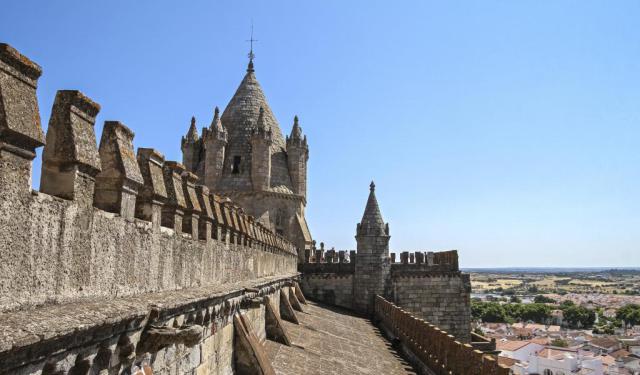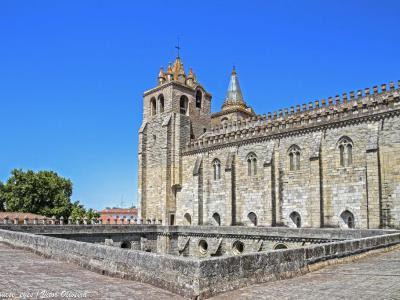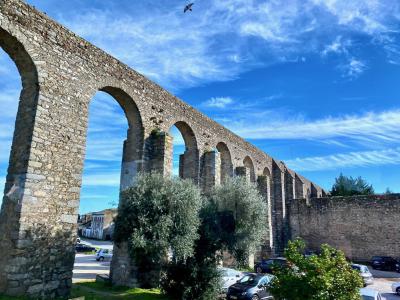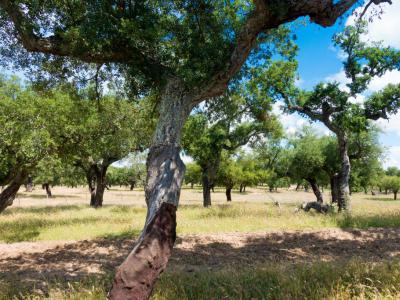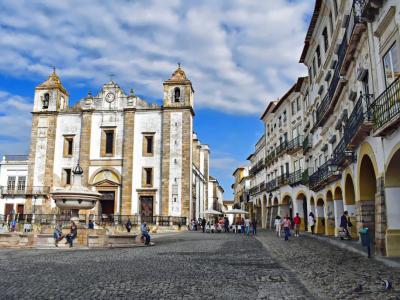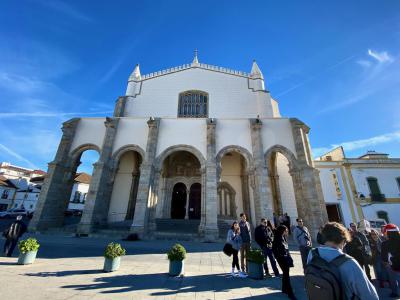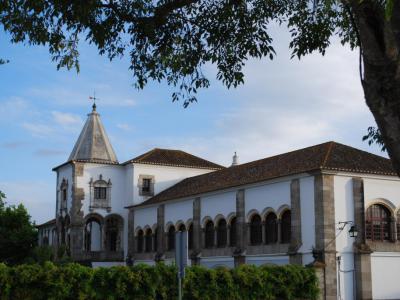Evora Introduction Walking Tour (Self Guided), Evora
Nestling in the sun-drenched Alentejo region of Portugal, Évora is a timeless gem in the heart of the country and one of its oldest and most enchanting cities.
The city's history spans over 5,000 years. The name Évora originates from the Celtic word "ebura," which means "of the yew trees."
The Romans conquered the place in 57 BC, shaping it into a vital town at the crossroads of significant routes. The weathered columns of the Roman Temple (Templo Romano) stand as reminders of that era. From 715 to 1165, the town was occupied by the Moors, who also influenced its character. In 1165, Gerald the Fearless reclaimed Évora from the Moors, incorporating it into Portugal.
During the Middle Ages, Évora flourished as a center of learning and the arts, garnering support from a succession of Portuguese kings. The 18th century saw a decline prompted by Jesuit expulsion. The Battle of Évora, in 1808, marked the dark period of French invasion, which was followed by the Portuguese Civil War series lasting until 1834.
Standing proudly amidst the local architectural marvels is the majestic Cathedral of Evora (Catedral de Évora), a soaring testament to masonry brilliance.
As you venture further into the city, the Church of Saint John the Evangelist (Igreja de São João Evangelista) emerges as a hidden gem; its elegant simplicity draws you into a serene realm of contemplation. Not far away, the venerable University of Evora (Universidade de Évora), founded in 1559, continues its legacy as one of the oldest universities in Portugal.
A visit to Évora is incomplete without a stop at Giraldo Square (Praça do Giraldo). This vibrant hub of activity brims with life as the locals and visitors converge. The bustling square captures the spirit of Évora, offering a spirited atmosphere and a glimpse into its everyday life.
Évora is a time capsule where history and architecture intertwine, inviting you to wander through the stories etched in its cobblestone streets. Embrace the charm of Évora as you explore it and soak in its culture. Your journey through Évora promises to be a memorable one, leaving you with a deeper appreciation for the past and a sense of connection to the present.
The city's history spans over 5,000 years. The name Évora originates from the Celtic word "ebura," which means "of the yew trees."
The Romans conquered the place in 57 BC, shaping it into a vital town at the crossroads of significant routes. The weathered columns of the Roman Temple (Templo Romano) stand as reminders of that era. From 715 to 1165, the town was occupied by the Moors, who also influenced its character. In 1165, Gerald the Fearless reclaimed Évora from the Moors, incorporating it into Portugal.
During the Middle Ages, Évora flourished as a center of learning and the arts, garnering support from a succession of Portuguese kings. The 18th century saw a decline prompted by Jesuit expulsion. The Battle of Évora, in 1808, marked the dark period of French invasion, which was followed by the Portuguese Civil War series lasting until 1834.
Standing proudly amidst the local architectural marvels is the majestic Cathedral of Evora (Catedral de Évora), a soaring testament to masonry brilliance.
As you venture further into the city, the Church of Saint John the Evangelist (Igreja de São João Evangelista) emerges as a hidden gem; its elegant simplicity draws you into a serene realm of contemplation. Not far away, the venerable University of Evora (Universidade de Évora), founded in 1559, continues its legacy as one of the oldest universities in Portugal.
A visit to Évora is incomplete without a stop at Giraldo Square (Praça do Giraldo). This vibrant hub of activity brims with life as the locals and visitors converge. The bustling square captures the spirit of Évora, offering a spirited atmosphere and a glimpse into its everyday life.
Évora is a time capsule where history and architecture intertwine, inviting you to wander through the stories etched in its cobblestone streets. Embrace the charm of Évora as you explore it and soak in its culture. Your journey through Évora promises to be a memorable one, leaving you with a deeper appreciation for the past and a sense of connection to the present.
How it works: Download the app "GPSmyCity: Walks in 1K+ Cities" from Apple App Store or Google Play Store to your mobile phone or tablet. The app turns your mobile device into a personal tour guide and its built-in GPS navigation functions guide you from one tour stop to next. The app works offline, so no data plan is needed when traveling abroad.
Evora Introduction Walking Tour Map
Guide Name: Evora Introduction Walking Tour
Guide Location: Portugal » Evora (See other walking tours in Evora)
Guide Type: Self-guided Walking Tour (Sightseeing)
# of Attractions: 12
Tour Duration: 2 Hour(s)
Travel Distance: 3.3 Km or 2.1 Miles
Author: DanaOffice
Sight(s) Featured in This Guide:
Guide Location: Portugal » Evora (See other walking tours in Evora)
Guide Type: Self-guided Walking Tour (Sightseeing)
# of Attractions: 12
Tour Duration: 2 Hour(s)
Travel Distance: 3.3 Km or 2.1 Miles
Author: DanaOffice
Sight(s) Featured in This Guide:
- Catedral de Evora (Cathedral of Evora)
- Templo Romano Evora (Roman Temple of Evora)
- Igreja de Sao Joao Evangelista (Church of Saint John the Evangelist)
- Universidade de Evora (University of Evora)
- Agua de Prata Aqueduct (Silver Water Aqueduct)
- Muralhas de Evora (Walls of Evora)
- Casa do Montado (Montado House)
- Praça do Giraldo (Giraldo Square)
- Igreja de São Francisco (Church of St. Francis)
- Capela dos Ossos (Chapel of Bones)
- Paco Real de Evora (Royal Palace of Évora)
- Jardim Publico de Evora (Evora Public Park)
1) Catedral de Evora (Cathedral of Evora) (must see)
The Cathedral is a roman Catholic church that holds a significant place in the hearts of both locals and visitors alike, gracing the highest point of the city. It serves as the spiritual and administrative seat of the Archdiocese of Évora.
Designated as a UNESCO World Heritage Site in 1988, the Cathedral of Évora has weathered the sands of time and witnessed the ebb and flow of history. Its origins trace back to the 12th century when Évora was definitively recaptured from Arab control by Geraldo Sem Pavor (Gerald the Fearless) in 1166. This victory marked the commencement of the construction of a cathedral dedicated to the Virgin Mary. The initial structure, built between 1186 and 1204, was relatively modest in scale. However, it underwent significant expansion in the early 14th century, embodying the graceful lines of early Gothic architecture.
The cathedral's evolution continued, with each passing century leaving its mark. The Gothic cloisters, dating back to the 14th century, create an aura of tranquility, inviting visitors to stroll through their elegant arches and contemplate the passage of time. A Manueline chapel known as the Esporão, crafted in the early 16th century, speaks to the ornate artistry of the era. One of the most remarkable additions, the grand main chapel in baroque style, was erected during the first half of the 18th century, showcasing the opulence and grandeur of that period.
Designated as a UNESCO World Heritage Site in 1988, the Cathedral of Évora has weathered the sands of time and witnessed the ebb and flow of history. Its origins trace back to the 12th century when Évora was definitively recaptured from Arab control by Geraldo Sem Pavor (Gerald the Fearless) in 1166. This victory marked the commencement of the construction of a cathedral dedicated to the Virgin Mary. The initial structure, built between 1186 and 1204, was relatively modest in scale. However, it underwent significant expansion in the early 14th century, embodying the graceful lines of early Gothic architecture.
The cathedral's evolution continued, with each passing century leaving its mark. The Gothic cloisters, dating back to the 14th century, create an aura of tranquility, inviting visitors to stroll through their elegant arches and contemplate the passage of time. A Manueline chapel known as the Esporão, crafted in the early 16th century, speaks to the ornate artistry of the era. One of the most remarkable additions, the grand main chapel in baroque style, was erected during the first half of the 18th century, showcasing the opulence and grandeur of that period.
2) Templo Romano Evora (Roman Temple of Evora) (must see)
The Roman Temple of Évora is a remarkable ancient structure. It holds significant historical and cultural value, representing a link between the Roman and Lusitanian civilizations that once thrived in the region. This temple is particularly notable for its connection to Augustus, the Roman emperor, as well as its place in the urban landscape of Évora.
Believed to have been constructed around the 1st century CE, the temple was dedicated to the veneration of Augustus, who was deified and worshipped as a god both during and after his reign. Its location within the main public square, formerly called Liberalitas Iulia, highlights its importance as a focal point of religious and administrative activities during the Roman era. As part of the city's transformation in the 2nd and 3rd centuries, the temple underwent modifications, reflecting the evolving religious and societal priorities of the time.
Tragically, the temple suffered destruction during the 5th century at the hands of invading Germanic groups, which marked the end of its original glory. However, even in its ruined state, the temple remains a testament to the architectural and cultural achievements of the past.
Positioned in the heart of Évora's central square, the temple holds a strategic location that once formed the highest point of the city's acropolis. It is surrounded by other historical and religious structures, including the Sé Cathedral, the Palace of the Inquisitor, the Palace of the Dukes of Cadaval, the Court of the Inquisition, the Church and Lóios' Convent, as well as the Public Library and Museum of Évora. This congregation of diverse buildings serves as a tangible representation of the city's rich history, showcasing various facets of its past.
Believed to have been constructed around the 1st century CE, the temple was dedicated to the veneration of Augustus, who was deified and worshipped as a god both during and after his reign. Its location within the main public square, formerly called Liberalitas Iulia, highlights its importance as a focal point of religious and administrative activities during the Roman era. As part of the city's transformation in the 2nd and 3rd centuries, the temple underwent modifications, reflecting the evolving religious and societal priorities of the time.
Tragically, the temple suffered destruction during the 5th century at the hands of invading Germanic groups, which marked the end of its original glory. However, even in its ruined state, the temple remains a testament to the architectural and cultural achievements of the past.
Positioned in the heart of Évora's central square, the temple holds a strategic location that once formed the highest point of the city's acropolis. It is surrounded by other historical and religious structures, including the Sé Cathedral, the Palace of the Inquisitor, the Palace of the Dukes of Cadaval, the Court of the Inquisition, the Church and Lóios' Convent, as well as the Public Library and Museum of Évora. This congregation of diverse buildings serves as a tangible representation of the city's rich history, showcasing various facets of its past.
3) Igreja de Sao Joao Evangelista (Church of Saint John the Evangelist)
The Church of Saint John Evangelista was founded in 1485 by Rodrigo Afonso de Melo, the Count of Olivença and the first governor of Tangier. The Church of Saint John Evangelista has witnessed centuries of history and served as a place of worship and contemplation. Its enduring connection with the Dukes of Cadaval has helped preserve its legacy and maintain it in good condition to this day.
The church's architectural style showcases a blend of Gothic elements, including a prominent Gothic portal, which serves as a visually captivating entrance that welcomes visitors into the spiritual realm of the church. However, one of the most distinctive features of the interior lies in the meticulously adorned nave. The entire nave is adorned with hand-painted tiles, an artistic marvel dating back to 1711 and attributed to António de Oliveira Bernardes. These tiles are widely regarded as some of the finest examples of this traditional Portuguese craft, contributing to the church's unique aesthetic appeal.
Beneath the surface, the Church of São João Evangelista holds more hidden treasures. Accessible through the railings on the floor of the adjacent Convent of Lóios, an underground world unfolds. A deep cistern, once vital for supplying water, offers a glimpse into the practicality of historic architecture. Additionally, an ossuary can be found here, a resting place for the remains of monks who once resided in the convent. This poignant reminder of the lives that were once lived within these walls adds a layer of depth and reflection to the church's history.
Inside the church, the sacristy unveils even more treasures, in the form of older tiles that offer a window into the past. These tiles provide a tangible link to the craftsmanship and artistic expression of earlier eras, highlighting the enduring cultural significance of the church.
The church's architectural style showcases a blend of Gothic elements, including a prominent Gothic portal, which serves as a visually captivating entrance that welcomes visitors into the spiritual realm of the church. However, one of the most distinctive features of the interior lies in the meticulously adorned nave. The entire nave is adorned with hand-painted tiles, an artistic marvel dating back to 1711 and attributed to António de Oliveira Bernardes. These tiles are widely regarded as some of the finest examples of this traditional Portuguese craft, contributing to the church's unique aesthetic appeal.
Beneath the surface, the Church of São João Evangelista holds more hidden treasures. Accessible through the railings on the floor of the adjacent Convent of Lóios, an underground world unfolds. A deep cistern, once vital for supplying water, offers a glimpse into the practicality of historic architecture. Additionally, an ossuary can be found here, a resting place for the remains of monks who once resided in the convent. This poignant reminder of the lives that were once lived within these walls adds a layer of depth and reflection to the church's history.
Inside the church, the sacristy unveils even more treasures, in the form of older tiles that offer a window into the past. These tiles provide a tangible link to the craftsmanship and artistic expression of earlier eras, highlighting the enduring cultural significance of the church.
4) Universidade de Evora (University of Evora)
The University of Évora holds a remarkable legacy as the second oldest university in the country. Its establishment in 1559 by Cardinal Henry, who would later become the king of Portugal, along with the approval of Pope Paul IV, conferred the institution with university status. It's a testament to its enduring significance that this historical moment is chronicled in the papal bull Cum a nobis.
The university's early years were shaped under the patronage of the Society of Jesus, more commonly known as the Jesuits. This affiliation with the Jesuits played a pivotal role in both the university's rise to scholarly prominence and its eventual trials during the Marquis of Pombal's Jesuit suppression. The Marquis of Pombal's decree led to the university's closure in 1779, accompanied by the imprisonment or exile of its faculty members.
However, the spirit of education persisted, and after almost two centuries, the university was revitalized in 1973 as the Instituto Universitário de Évora (University Institute of Évora). This rejuvenation was orchestrated by José Veiga Simão, the Minister of Education at the time, as part of broader educational reforms aimed at reshaping higher education in Portugal. By 1979, the institution reclaimed its original name, Universidade de Évora, marking the culmination of its resurrection.
The university's historic significance is not only rooted in its age but also in its rich academic contributions. The Colégio do Espírito Santo, the university's historical college, flourished as a center of learning and scholarly excellence, rivaling even the famed University of Coimbra. The institution nurtured a cadre of eminent theologians, philosophers, and thinkers, including figures like Luis de Molina, Pedro de Fonseca, St. Francisco de Borja, St. João de Brito, and Manuel Álvares.
The university's early years were shaped under the patronage of the Society of Jesus, more commonly known as the Jesuits. This affiliation with the Jesuits played a pivotal role in both the university's rise to scholarly prominence and its eventual trials during the Marquis of Pombal's Jesuit suppression. The Marquis of Pombal's decree led to the university's closure in 1779, accompanied by the imprisonment or exile of its faculty members.
However, the spirit of education persisted, and after almost two centuries, the university was revitalized in 1973 as the Instituto Universitário de Évora (University Institute of Évora). This rejuvenation was orchestrated by José Veiga Simão, the Minister of Education at the time, as part of broader educational reforms aimed at reshaping higher education in Portugal. By 1979, the institution reclaimed its original name, Universidade de Évora, marking the culmination of its resurrection.
The university's historic significance is not only rooted in its age but also in its rich academic contributions. The Colégio do Espírito Santo, the university's historical college, flourished as a center of learning and scholarly excellence, rivaling even the famed University of Coimbra. The institution nurtured a cadre of eminent theologians, philosophers, and thinkers, including figures like Luis de Molina, Pedro de Fonseca, St. Francisco de Borja, St. João de Brito, and Manuel Álvares.
5) Agua de Prata Aqueduct (Silver Water Aqueduct)
The Silver Water Aqueduct was constructed during the reign of King João III. This intricate feat of architecture was designed to provide the city of Évora with a reliable water supply. The aqueduct was inaugurated in 1537 and remains a functional conduit for water even today, making it a rare example of an engineering marvel from its era that still serves its original purpose.
The aqueduct's origin point is the springs located in Graça do Divor, situated within the premises of the São Bento de Castris Convent. These springs, with their initial source traced to Herdade das Figueiras de Lobo, provide the water that the aqueduct channels to the city of Évora. The aqueduct stretches across an impressive distance of approximately 18 kilometers, showcasing the ingenuity and dedication of the architects and engineers involved in its creation.
The mind behind the Silver Water Aqueduct's design was none other than Francisco de Arruda, a royal architect of great renown. His vision and meticulous planning led to the successful realization of this water transportation system, which played a crucial role in sustaining the city's inhabitants. The aqueduct's construction commenced in 1531 under the direct orders of King João III, who recognized the significance of securing a consistent water supply for Évora.
The inauguration of the aqueduct on March 28, 1537, marked a significant achievement in engineering and infrastructure development. Its enduring presence has garnered it a rightful place on the UNESCO World Heritage List as an integral component of the Historic Center of Évora. Furthermore, its historical importance has led to its classification as a National Monument since 1910.
The aqueduct's origin point is the springs located in Graça do Divor, situated within the premises of the São Bento de Castris Convent. These springs, with their initial source traced to Herdade das Figueiras de Lobo, provide the water that the aqueduct channels to the city of Évora. The aqueduct stretches across an impressive distance of approximately 18 kilometers, showcasing the ingenuity and dedication of the architects and engineers involved in its creation.
The mind behind the Silver Water Aqueduct's design was none other than Francisco de Arruda, a royal architect of great renown. His vision and meticulous planning led to the successful realization of this water transportation system, which played a crucial role in sustaining the city's inhabitants. The aqueduct's construction commenced in 1531 under the direct orders of King João III, who recognized the significance of securing a consistent water supply for Évora.
The inauguration of the aqueduct on March 28, 1537, marked a significant achievement in engineering and infrastructure development. Its enduring presence has garnered it a rightful place on the UNESCO World Heritage List as an integral component of the Historic Center of Évora. Furthermore, its historical importance has led to its classification as a National Monument since 1910.
6) Muralhas de Evora (Walls of Evora)
The Walls of Évora form an integral part of the city's Historic Center, earning the esteemed status of a UNESCO World Heritage Site and receiving recognition as a National Monument since 1922.
This defensive marvel is a fusion of architectural styles and historical periods, reflecting the city's diverse past. The earliest incarnation of the walls dates back to the 3rd century, during the era of Roman influence and expansion. Constructed during the Romanization period, this initial defensive boundary encompassed a sprawling area of around ten hectares and spanned an impressive length of nearly two thousand meters. The Porta de D. Isabel, also known as the Roman Arch of Évora, stands as an enduring legacy from this period, a portal to the city's past.
As history evolved, so did the walls. From the days of the Visigothic reign, a monumental presence emerges in the form of the quadrangular Tower, often referred to as the Tower of Sisebuto. This tower, attributed to King Sisebuto who ruled in the 7th century, anchors the walls with a tangible connection to that era. Despite the passage of time, the exact transformations that occurred during this period remain shrouded in mystery, leaving only tantalizing traces of the walls' evolution.
With the Islamic period weaving its influence through the city's chronicles, the walls too underwent changes, although these transformations are obscured by the mists of time. Echoes of this era persist in remnants scattered discreetly around the Cathedral and the Roman Temple, whispering tales of a bygone era.
This defensive marvel is a fusion of architectural styles and historical periods, reflecting the city's diverse past. The earliest incarnation of the walls dates back to the 3rd century, during the era of Roman influence and expansion. Constructed during the Romanization period, this initial defensive boundary encompassed a sprawling area of around ten hectares and spanned an impressive length of nearly two thousand meters. The Porta de D. Isabel, also known as the Roman Arch of Évora, stands as an enduring legacy from this period, a portal to the city's past.
As history evolved, so did the walls. From the days of the Visigothic reign, a monumental presence emerges in the form of the quadrangular Tower, often referred to as the Tower of Sisebuto. This tower, attributed to King Sisebuto who ruled in the 7th century, anchors the walls with a tangible connection to that era. Despite the passage of time, the exact transformations that occurred during this period remain shrouded in mystery, leaving only tantalizing traces of the walls' evolution.
With the Islamic period weaving its influence through the city's chronicles, the walls too underwent changes, although these transformations are obscured by the mists of time. Echoes of this era persist in remnants scattered discreetly around the Cathedral and the Roman Temple, whispering tales of a bygone era.
7) Casa do Montado (Montado House)
Montado House is an extraordinary exhibition space that has been meticulously designed to honor the rich history and distinct features of the building itself. It also serves as a beacon for the unique heritage of the Montado, the cork oak agroforest that has shaped the land and culture of the Alentejo region.
The Montado House is a harmonious fusion of past and present, where the authenticity of its architecture meets the modern spirit of preservation and education. Comprising 12 intricately designed rooms, along with two inviting outdoor spaces, the exhibit serves as a gateway to the realm of the cork oak forest. It's a journey that transcends mere display, delving into the very heart of the Montado's story.
Within these walls, seven rooms are dedicated to immersing visitors in the captivating narrative of the Mediterranean Forest. The first room sets the stage, elaborating on the nature of this unique ecosystem and its distinguishing characteristics. As guests explore further, they encounter rooms brimming with the vibrant tales of Fauna and Flora, highlighting the astonishing biodiversity that flourishes within the cork oak forest's embrace.
The Montado, a cradle of cultural and ethnographic heritage, finds its own tribute in a dedicated space, weaving together the threads of tradition and heritage that are integral to the Alentejo region's identity. The legacy of Cork Stripping, an ancient craft in danger of fading into obscurity, is revived here, allowing visitors to witness the mastery of this traditional practice before it vanishes entirely.
The Montado House is a harmonious fusion of past and present, where the authenticity of its architecture meets the modern spirit of preservation and education. Comprising 12 intricately designed rooms, along with two inviting outdoor spaces, the exhibit serves as a gateway to the realm of the cork oak forest. It's a journey that transcends mere display, delving into the very heart of the Montado's story.
Within these walls, seven rooms are dedicated to immersing visitors in the captivating narrative of the Mediterranean Forest. The first room sets the stage, elaborating on the nature of this unique ecosystem and its distinguishing characteristics. As guests explore further, they encounter rooms brimming with the vibrant tales of Fauna and Flora, highlighting the astonishing biodiversity that flourishes within the cork oak forest's embrace.
The Montado, a cradle of cultural and ethnographic heritage, finds its own tribute in a dedicated space, weaving together the threads of tradition and heritage that are integral to the Alentejo region's identity. The legacy of Cork Stripping, an ancient craft in danger of fading into obscurity, is revived here, allowing visitors to witness the mastery of this traditional practice before it vanishes entirely.
8) Praça do Giraldo (Giraldo Square) (must see)
Giraldo Square is a remarkable historical site that pays homage to the valiant Geraldo Geraldes, a figure of great significance in the city's history. This iconic square stands as a testament to his conquest of Évora from the Moors in 1167. Geraldo Geraldes, known as Fearless Geraldo, played a pivotal role in the city's liberation, a feat that was recognized by King Afonso Henriques, the first king of Portugal.
To honor Geraldo Geraldes, King Afonso Henriques appointed him as the Governor of Évora (alcaide of Évora) and bestowed upon him the title of High Protector of the Borders of Alentejo, a region that he had played a vital role in conquering. The coat of arms of Évora, which is showcased prominently, features Geraldo Geraldes mounted on a horse, brandishing his sword. At the base of the coat of arms are depicted the heads of a Moor and his daughter, symbolizing his conquest of the city and the castle, respectively.
Over the centuries, Giraldo Square has undergone various transformations, but its historical and cultural significance remains intact. Originally, the square held sculptures and a triumphal arch, but these were sacrificed to construct the grand baroque-style fountain that now graces the center of the square. This fountain, crafted from marble, features eight spouts, each representing a major street leading to and from the square. At its pinnacle rests a crown, a nod to the story that King Philip III of Spain considered the fountain worthy of coronation in 1619.
Though the water still flows from its spouts, the fountain is now often frequented by pigeons seeking relief from the heat. While drinking from the fountain might not be advisable due to the avian inhabitants, it remains a centerpiece that captures the attention of both locals and tourists.
To honor Geraldo Geraldes, King Afonso Henriques appointed him as the Governor of Évora (alcaide of Évora) and bestowed upon him the title of High Protector of the Borders of Alentejo, a region that he had played a vital role in conquering. The coat of arms of Évora, which is showcased prominently, features Geraldo Geraldes mounted on a horse, brandishing his sword. At the base of the coat of arms are depicted the heads of a Moor and his daughter, symbolizing his conquest of the city and the castle, respectively.
Over the centuries, Giraldo Square has undergone various transformations, but its historical and cultural significance remains intact. Originally, the square held sculptures and a triumphal arch, but these were sacrificed to construct the grand baroque-style fountain that now graces the center of the square. This fountain, crafted from marble, features eight spouts, each representing a major street leading to and from the square. At its pinnacle rests a crown, a nod to the story that King Philip III of Spain considered the fountain worthy of coronation in 1619.
Though the water still flows from its spouts, the fountain is now often frequented by pigeons seeking relief from the heat. While drinking from the fountain might not be advisable due to the avian inhabitants, it remains a centerpiece that captures the attention of both locals and tourists.
9) Igreja de São Francisco (Church of St. Francis)
The Church of Saint Francis was originally built in the Gothic style with influences from the Manueline architectural movement. The construction of the Church of Saint Francis spanned several decades, from 1475 to the 1550s. Its distinctive design was the creation of Martim Lourenço, who fashioned this grand edifice to replace a prior Romanesque church dating back to 1226.
The church's uniqueness becomes evident upon first glance, with a narthex adorned with captivating arcades that grace its front. This arcade, featuring seven arches of varying forms – semicircular, pointed, and horseshoe – showcases an intriguing fusion of Gothic and Moorish elements, reflecting the diverse influences that shaped Portugal's architectural heritage.
The exterior of the church boasts a battlemented façade crowned by conical and spiral-shaped spires, with an intricately carved Manueline entrance. This entrance carries emblematic symbols, including the pelican, the emblem of King João II, and the armillary, symbolizing King Manuel I.
The church's dimensions are truly impressive, measuring 36 meters in length, 34 meters in width, and 24 meters in height. The singular, groin-vaulted nave creates an expansive atmosphere, further enhanced by the application of white mortar on the walls and columns. Notably, this nave is the largest of its kind found in Portuguese churches. The soaring vault of the crossing, supported by ogival arches, adds to the grandeur of the interior space.
The church's uniqueness becomes evident upon first glance, with a narthex adorned with captivating arcades that grace its front. This arcade, featuring seven arches of varying forms – semicircular, pointed, and horseshoe – showcases an intriguing fusion of Gothic and Moorish elements, reflecting the diverse influences that shaped Portugal's architectural heritage.
The exterior of the church boasts a battlemented façade crowned by conical and spiral-shaped spires, with an intricately carved Manueline entrance. This entrance carries emblematic symbols, including the pelican, the emblem of King João II, and the armillary, symbolizing King Manuel I.
The church's dimensions are truly impressive, measuring 36 meters in length, 34 meters in width, and 24 meters in height. The singular, groin-vaulted nave creates an expansive atmosphere, further enhanced by the application of white mortar on the walls and columns. Notably, this nave is the largest of its kind found in Portuguese churches. The soaring vault of the crossing, supported by ogival arches, adds to the grandeur of the interior space.
10) Capela dos Ossos (Chapel of Bones) (must see)
The Chapel of Bones, located in Évora, is a hauntingly unique and intriguing monument that has captivated visitors from around the world. Situated adjacent to the entrance of the Church of Saint Francis, this small interior chapel stands as a somber reminder of mortality and the transient nature of human existence. Its name alone - "Chapel of Bones" - evokes a sense of both curiosity and solemn reflection.
The history of the Chapel of Bones dates back to the Franciscan friars who constructed it. This chapel serves as a macabre embodiment of their philosophy, demonstrating the impermanence of life and the inevitability of death. In a display that can be both chilling and awe-inspiring, the interior walls are adorned with thousands of human skulls and bones. These bones were sourced from the remains of ordinary people who were once interred in Évora's medieval cemeteries.
The process of creating this morbid yet strangely artistic arrangement involved exhuming approximately 5,000 corpses. These remains were then meticulously positioned by the Franciscans to form an assortment of patterns and designs, transforming the chapel into a labyrinth of bones. The architecture of the chapel is also noteworthy, with three spans measuring 18.7 meters in length and 11 meters in width. Illumination filters through three small openings on the left, casting an eerie light upon the walls of bones.
The history of the Chapel of Bones dates back to the Franciscan friars who constructed it. This chapel serves as a macabre embodiment of their philosophy, demonstrating the impermanence of life and the inevitability of death. In a display that can be both chilling and awe-inspiring, the interior walls are adorned with thousands of human skulls and bones. These bones were sourced from the remains of ordinary people who were once interred in Évora's medieval cemeteries.
The process of creating this morbid yet strangely artistic arrangement involved exhuming approximately 5,000 corpses. These remains were then meticulously positioned by the Franciscans to form an assortment of patterns and designs, transforming the chapel into a labyrinth of bones. The architecture of the chapel is also noteworthy, with three spans measuring 18.7 meters in length and 11 meters in width. Illumination filters through three small openings on the left, casting an eerie light upon the walls of bones.
11) Paco Real de Evora (Royal Palace of Évora)
The Royal Palace of Évora, also known as the Royal Palace of São Francisco and the Palace of King Manuel I, stands as a testament to Portugal's regal history and architectural splendor.
Originally established as a convent in the 13th century, the palace's early days were marked by the tranquil spirituality of its monastic inhabitants. In the 14th century, when the royal family sought refuge in the Alentejo region, the convent opened its doors to accommodate them. However, it was under the reign of King John I that the palace began its journey towards becoming a royal abode of grandeur. The king utilized the palace as a personal retreat, setting the stage for its eventual transformation.
Over the following generations, the Royal Palace of Évora underwent a series of renovations and expansions. It wasn't until the reigns of King John II and Manuel I that the palace truly flourished into a masterpiece of Renaissance architecture, befitting of royalty. Within the palace's walls, history was made. Playwrights like Gil Vicente and explorers like Vasco da Gama graced its chambers, seeking the favor and audience of the king.
After serving as an Archaeological Museum, theater, and exhibition space since 1865, tragedy struck in 1881 when a collapse destroyed its roofs. Adaptations followed, culminating in the transformation of the palace into the Teatro Eborense, a public theater house.
In 1943, a beacon of hope emerged as the National Monuments took on the task of restoration. The essential elements of the original design were salvaged, ensuring that the palace's legacy endured. The subsequent restoration work breathed new life into the palace, preserving its historical significance for generations to come.
Originally established as a convent in the 13th century, the palace's early days were marked by the tranquil spirituality of its monastic inhabitants. In the 14th century, when the royal family sought refuge in the Alentejo region, the convent opened its doors to accommodate them. However, it was under the reign of King John I that the palace began its journey towards becoming a royal abode of grandeur. The king utilized the palace as a personal retreat, setting the stage for its eventual transformation.
Over the following generations, the Royal Palace of Évora underwent a series of renovations and expansions. It wasn't until the reigns of King John II and Manuel I that the palace truly flourished into a masterpiece of Renaissance architecture, befitting of royalty. Within the palace's walls, history was made. Playwrights like Gil Vicente and explorers like Vasco da Gama graced its chambers, seeking the favor and audience of the king.
After serving as an Archaeological Museum, theater, and exhibition space since 1865, tragedy struck in 1881 when a collapse destroyed its roofs. Adaptations followed, culminating in the transformation of the palace into the Teatro Eborense, a public theater house.
In 1943, a beacon of hope emerged as the National Monuments took on the task of restoration. The essential elements of the original design were salvaged, ensuring that the palace's legacy endured. The subsequent restoration work breathed new life into the palace, preserving its historical significance for generations to come.
12) Jardim Publico de Evora (Evora Public Park)
Nestled within the heart of Evora, the historic city in Portugal, lies the enchanting Evora Public Park. This magnificent garden is a harmonious blend of vibrant vegetation, captivating colors, and an irresistible tranquility that beckons visitors to unwind and immerse themselves in its serene embrace. A true haven of romance, the park's various corners and hidden nooks inspire romantic sentiments, making it a cherished spot for locals and tourists alike.
However, the park is not just a place of natural beauty; it's a space steeped in history and architectural significance. As you explore its sprawling grounds, you'll find yourself traversing through time, encountering remnants of the past that speak to the city's rich heritage. Among the notable monuments that grace the park's landscape are the remains of the Medieval Wall dating back to the 14th century, the stately D. Manuel Palace from the 16th century, and the intriguing "Ruínas Fingidas" or Fake Ruins from the 19th century.
One particularly captivating feature of the park is the 19th-century bandstand, a relic that bridges the gap between the past and modernity. This bandstand has not only witnessed numerous historical music concerts but also stands as a testament to the evolving cultural landscape of the park.
The "fake ruins" within the park are a testament to architectural ingenuity. Constructed using materials salvaged from various other monuments in the city, these ruins evoke a sense of nostalgia and romance. They comprise fragments of twinned windows in Manueline and Mudejar styles, artfully integrated into a tower and a section of the medieval wall.
These faux ruins evoke the Romantic ideals of the 19th-century gardens, adding an air of whimsy and historical fantasy to the park's ambiance. Above these "ruins," the graceful presence of peacocks further enriches the surroundings, their vivid plumage adding a touch of vibrant elegance.
However, the park is not just a place of natural beauty; it's a space steeped in history and architectural significance. As you explore its sprawling grounds, you'll find yourself traversing through time, encountering remnants of the past that speak to the city's rich heritage. Among the notable monuments that grace the park's landscape are the remains of the Medieval Wall dating back to the 14th century, the stately D. Manuel Palace from the 16th century, and the intriguing "Ruínas Fingidas" or Fake Ruins from the 19th century.
One particularly captivating feature of the park is the 19th-century bandstand, a relic that bridges the gap between the past and modernity. This bandstand has not only witnessed numerous historical music concerts but also stands as a testament to the evolving cultural landscape of the park.
The "fake ruins" within the park are a testament to architectural ingenuity. Constructed using materials salvaged from various other monuments in the city, these ruins evoke a sense of nostalgia and romance. They comprise fragments of twinned windows in Manueline and Mudejar styles, artfully integrated into a tower and a section of the medieval wall.
These faux ruins evoke the Romantic ideals of the 19th-century gardens, adding an air of whimsy and historical fantasy to the park's ambiance. Above these "ruins," the graceful presence of peacocks further enriches the surroundings, their vivid plumage adding a touch of vibrant elegance.
The Most Popular Cities
/ view all
